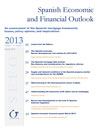An assessment of the Spanish mortgage framework: Issues, policy options, and implications
Fecha: 2013
Spanish and International Economic & Financial Outlook, SEFO, V. 2 N.º 2
Sumario
[expand title= "The Spanish economy: Recent developments and outlook for 2013-2014 "]- The first few months of 2013 point to an improvement in the advanced economies’ situation, albeit a somewhat uneven one. Emerging economies, which had suffered a marked slowdown in growth in 2012, enjoyed a recovery in the final months of the year. In Spain, GDP growth is expected to remain negative until the third quarter of 2013, when it will start to grow slightly in the final months of the year, and continue to grow moderately over the course of 2014. External financial restrictions have eased in recent months, and major Spanish banking institutions have been able to return to international financial markets, although sporadically and facing high costs. Nevertheless, the effect will not be immediately apparent in the real economy. Domestic credit constraints will continue until institutions complete the restructuring process and are able to fully access international markets on similar terms to institutions in other euro area countries. This means that no easing of financial conditions is likely to be seen until at least the second half of the year.
- Leer más
- Spanish households are facing a substantial deleveraging challenge. Even if the average mortgage loan has declined from 150,647 euros in 2009 to 112,875 euros in 2012, residential mortgage debt still represents around 64% of Spanish GDP. Additionally, Spain is the fourth largest mortgage market in Europe. Taking mortgage-backed securities and covered bonds together, it is the second largest country in the EU (only after the United Kingdom) in terms of securitized mortgage debt, with an outstanding volume of 683 billion euros. Although macroeconomic conditions have not been favorable, the quality of the mortgage portfolio of Spanish banks has not deteriorated significantly. The non-performing ratio of these loans (NPL) was 3.49% in 2012Q3. Despite this relatively low level of NPLs, foreclosures have been increasing. Recently, they have been particularly on the rise, such that foreclosures and evictions have caused significant social debate surrounding mortgage regulation in Spain. The Government is supportive of several measures currently under Parliamentary debate designed to alleviate pressures on mortgage debtors; however, opposed to the proposal to reform retroactively dation in payment. In our view, implementing retroactive non recourse mortgages would be more harmful than beneficial for the Spanish economy, thus, providing support to the Government’s position.
- Leer más
- Several supply and demand side factors are attributed to fuelling Spain’s property market bubble from 1997-2008 and its subsequent collapse coinciding with the global financial crisis. This article sets out to examine supply and demand side determinants of Spain’s housing market, such as population growth, household incomes, unemployment, production costs, real interest rates, and house prices, among others. At present, it appears that most of the factors that worked together to promote the property boom between 1997 and 2008 are now conspiring to prolong the crisis in this sector. The negative impact of slow population growth and high unemployment largely outweighs the positive impact of lower prices on housing demand. This is the challenging scenario SAREB will likely face as it attempts to implement its mandate and sell off property assets transferred from the Spanish financial system.
- Leer más
- The historical connection between banking and life insurance products has boosted the development of the bancassurance sector in Spain, becoming the main distribution channel for insurance products in this country, above traditional channels, such as agents and insurance brokers. The reduction in the number of deposit institutions through several integration processes, a direct consequence of the present financial crisis, has caused conflicts among the different commercialization agreements established between insurance and credit institutions. Entities involved must solve these conflicts before January 1st 2014, as required by the Bank of Spain.
- Leer más
- Regulators and market participants have become increasingly concerned about the Spanish electricity tariff deficit due to its size and the difficulties to control its growth. The deficit can be traced to inefficiencies in market organization and solutions should be designed to mitigate those inefficiencies. Tariff deficits have allowed for the transfer of part of the present costs of electricity services to future consumers, but this situation has reached a limit and a deep revision of regulation in this market cannot be postponed. In general, solutions that interfere with market prices and signals are not appropriate.
- Leer más

